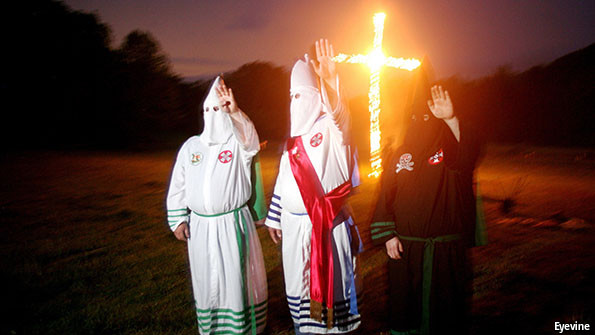 SUNFLOWERS, marigolds and lavender grow outside houses in Cabbagetown, a neighbourhood a mile away from the birthplace of Martin Luther King. But residents there awoke in recent days to an ugly reality: recruiting flyers for the Ku Klux Klan (KKK) on their cars.
SUNFLOWERS, marigolds and lavender grow outside houses in Cabbagetown, a neighbourhood a mile away from the birthplace of Martin Luther King. But residents there awoke in recent days to an ugly reality: recruiting flyers for the Ku Klux Klan (KKK) on their cars.
The leaflets are full of catchy slogans, such as “Save our land, join the Klan”, and a number to call for more information. Some came with a mint. Similar literature has been distributed in North Carolina, South Carolina and Florida. Most of it seems to come from the Loyal White Knights of the Ku Klux Klan, perhaps America’s largest chapter, based in North Carolina. Such distributions apparently happen three times a year according to Robert Jones, the group’s Imperial Klaliff. “A lot more have been joining since the immigration crisis,” he boasts.
The Ku Klux Klan was founded in 1865 as a club that targeted African-Americans, homosexuals and Jews in the wake of the civil war. Peak membership came in 1925, when these white-hooded crusaders numbered around 4m. But the KKK continued to be a lethal force through the 1960s, and is credited with killing and maiming countless blacks and civil-rights activists.
These days the KKK is a shadow of its former self. There are fewer than 8,000 members of different warring factions (and some suggest the number is closer to 6,000), according to Mark Potok from the Southern Poverty Law Centre, which monitors hate groups in the region. The number of Klaverns (ie, local KKK units) temporarily rose after Barack Obama took office to 220 in 2010, but then fell again to 163 last year.
The KKK and other extreme outfits grew significantly during the early 2000s, says Mr Potok. The groups capitalised on mounting opposition to immigration, and tailored their message accordingly. Such pragmatism seems to be in play once again, particularly with so many Americans grumbling over the latest influx of child migrants. The phone number listed on many of the fliers connects callers to a brash male recorded voice, who informs people of the many ills associated with Mexican immigrants. Apparently they can be blamed for bringing leprosy and tuberculosis into the country, among other things. The solution? America could station federal troops at the Southern border “with a shoot to kill policy.”
The Imperial Klaliff was particularly pleased, he claimed, with the response generated by the recent leafleting campaign. Welcome packs for new recruits are being sent out to folks in California, Georgia, Illinois, North and South Carolina and Tennessee. My request for a more exact figure on membership was denied (apparently only higher ranking figures, such as the Grand Dragon or the Imperial Wizard, would know such things).
A veil of Christianity protects the right of Klans to exist under the constitution’s first amendment; rallies and cross burnings are still held across America. But any new recruits working for law-enforcement agencies are taking a risk: a deputy police chief and an officer from Florida’s Fruitland Park lost their jobs in the past week after their KKK memberships came to light.
Yet the Ku Klux Klan is no longer a real power to be reckoned with. Rather, the hateful club has become more of a novelty in America. Cameramen eager to capture these living relics often spoil staged ceremonies, complains Mr Jones.
No hay comentarios.:
Publicar un comentario